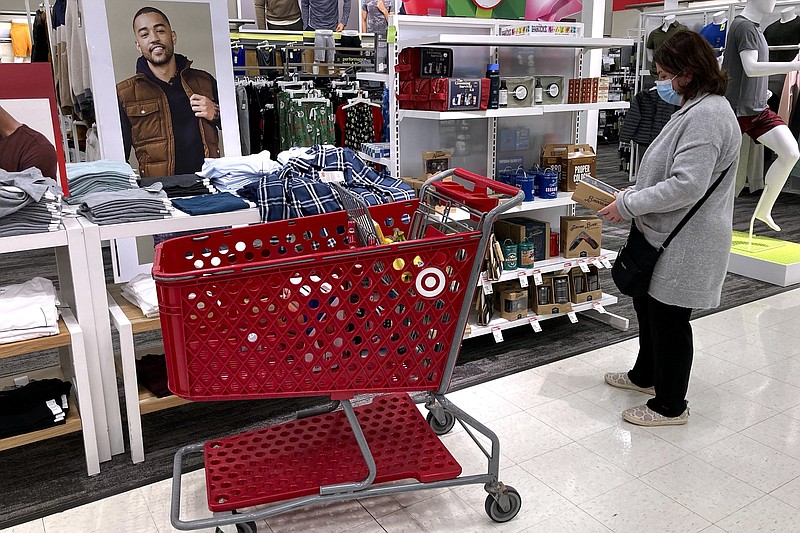Nearly two years of pandemic-related turmoil has affected virtually every aspect of retail, including how consumers shop, how much they spend, what they spend their money on -- and whether they can even find the items they want to buy.
Retailers will need to keep adapting to changing market conditions and consumer behavior to prosper in the year ahead, industry analysts say.
Consumer spending will continue to grow in 2022, but at a slower rate than this year and 2020, said Brian Yarbrough, a retail analyst with financial services firm Edward Jones.
Headwinds contributing to this deceleration, Yarbrough said, include the end of government stimulus funds. Plus, he said, the savings rate has returned to a more normal level of around 8% after peaking last year around 16%.
Those factors may cause consumers to pull back on spending, Yarbrough said. Continued inflation may also dampen consumers' willingness to spend, he said.
"Inflation is finally starting to float through retail," Yarbrough said. Consumers have already seen it in groceries, but it is just now showing up in hardlines such as appliances and sports equipment, and in softlines such as apparel and bedding, he said.
The new omicron variant of covid-19 is one wild card for retail, Yarbrough said, as are the child tax credits that end this month unless Congress renews them for next year.
Many consumers think these tax credits are stimulus funds, Yarbrough said. "But there could be some disappointment when people go to file their taxes and they get a lot less back than they did in 2020," since the checks were really advances on their annual child tax credit.
On the positive side, Yarbrough said, wages are growing and the housing markets are up. And people still have some savings, he said.
Despite some return to in-store shopping over this Christmas season, online sales will continue to outpace those made in stores, Yarbrough said. The omicron variant or any new one that crops up may accelerate that even further, he said.
SHIFT TO 'PRIORITIES'
Carol Spieckerman, a retail consultant and president of Spieckerman Retail, said 2022 "will mark a shift from possibilities to priorities."
Retailers were previously identifying what was possible for them in terms of capability, Spieckerman said.
"Now as retailers make acquisitions, forge new partnerships and build internal solutions, so many options and capabilities are open to them," Spieckerman said. So they need to shift their focus to identifying priorities and acknowledging that each retailer's priorities will be unique.
"There aren't any templates anymore," Spieckerman said.
Another shift will come as retailers increasingly become investors, she said, especially in startups that provide solutions and services in areas such as health care and transportation.
This will mean more owned assets for retailers and more competition for the established third-party providers that currently supply them with technology and data services, Spieckerman said.
"Plenty of third-party providers like Terra Cycle and thredUp on the sustainability front and a slew of last-mile enablers like Instacart have been able to work with competing retailers without a problem," Spieckerman said. But retailers who make direct investments in startups will lock many into exclusive contracts or acquire them outright.
"Either way, a torrent of technological innovation will hit retail in 2022," she said.
NEW PARTNERSHIPS
Sucharita Kodaly, a Forrester Research vice president and principal analyst, referred to a recent company report, which she co-wrote, on retail predictions for 2022.
The report said retailers will continue to look for and form new partnerships "to diversify everything from revenue sources to customers and channels."
For instance, store-within-store partnerships, such as Kohl's with Amazon and Sephora, and Target's with CVS and Ulta, will become more commonplace, the report said.
"Partnering with another retailer expands the footprint in often prime locations ... minus the expense of another full store," the report said. "For the host retailer, it refreshes assortment, grows overall per-square-foot sales, and lowers financial exposure."
According to the report, retailers will increasingly embrace the "circular economy" trend, in which clothing and other items are resold or re-purposed.
"Consumers like buying secondhand products because they're unique and less expensive -- and for the fun of finding a bargain or special item," the report said.
Forrester predicts that in 2022, "investment in companies that facilitate this logistically challenging offering will top $2 billion."
OUTLOOK FOR '22
Mark Cohen, director of retail studies and an adjunct professor at Columbia University's Graduate School of Business, said the pandemic will continue to drive change in retail and consumer behavior in the coming year.
Cohen said surges in hospitalizations and deaths from the covid-19 variants, especially in areas where many residents resist vaccination and safety protocols, will keep fueling the shift from retail store visits to online shopping that began well before the pandemic.
But with the end of government support that aided consumers, such as enhanced unemployment benefits and possibly the child tax credit, "disposable income will become entirely dependent upon wages," Cohen said.
"As a result, retail growth may become more muted than it has been recently while at the same time unemployment will continue to be unusually low," he said.
One bright note Cohen sees, though with a caveat, is that supply chain backlogs will continue to abate and will largely disappear by the end of 2022, "absent any further wide-scale covid-driven closures globally."
Overall, Cohen said, "Retailers who manage their assortments, their work force and their balance sheets to suit the realities we have been facing and will continue to face will continue to prosper."
On the other hand, "the retailers who were not in great shape pre-covid are not going to fare well in 2022 despite the optic that suggests that they are OK now," he said.
Cohen cautioned that sales performance in 2021 must be compared to that of 2018 and 2019 to get a true picture of the current situation.
"Comparisons to 2020, a year when closures and disruptions were widespread, are not valid," he said.
